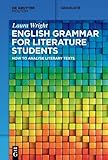English Grammar for Literature Students : How to Analyse Literary Texts / Laura Wright.
Material type: TextSeries: Mouton TextbookPublisher: Berlin ; Boston : De Gruyter Mouton, [2024]Copyright date: 2024Description: 1 online resource (VIII, 208 p.)Content type:
TextSeries: Mouton TextbookPublisher: Berlin ; Boston : De Gruyter Mouton, [2024]Copyright date: 2024Description: 1 online resource (VIII, 208 p.)Content type: - 9783111348414
- 9783111348896
- 428.2
- P53 .W75 2024
- online - DeGruyter
- Issued also in print.
| Item type | Current library | Call number | URL | Status | Notes | Barcode | |
|---|---|---|---|---|---|---|---|
 eBook
eBook
|
Biblioteca "Angelicum" Pont. Univ. S.Tommaso d'Aquino Nuvola online | online - DeGruyter (Browse shelf(Opens below)) | Online access | Not for loan (Accesso limitato) | Accesso per gli utenti autorizzati / Access for authorized users | (dgr)9783111348896 |
Frontmatter -- Acknowledgements -- Contents -- Introduction -- 1 On Nouns -- 2 Premodification in the Noun Phrase -- 3 On Adjectives -- 4 On Definite and Indefinite Articles -- 5 Personal Pronouns -- 6 Prepositional Phrases -- 7 On Verbs: Tense -- 8 Phrasal Verbs -- 9 Auxiliary Verbs -- 10 Auxiliary Verb do -- 11 Modal Auxiliary Verbs -- 12 On Aspect -- 13 Adverbs -- 14 Adverbials -- 15 On Clauses -- 16 On Clauses: Coordinators and Subordinators -- 17 On Clauses: Relative Pronouns -- 18 -ing forms -- 19 On Anaphora -- 20 On Cataphora -- 21 End Focus and Endweight -- 22 Collocation and Colligation -- 23 Cohesion and Coherence -- 24 Deixis -- 25 Conversational Implicatures -- 26 Speech Acts -- Primary Sources -- References
restricted access online access with authorization star
http://purl.org/coar/access_right/c_16ec
This book teaches the basics of the structure of the English language with plentiful extracts from novels, poems and plays, so that literature students learn how to identify parts of speech and discuss their effects. No previous linguistics experience is assumed. Each chapter is divided into a definition of a specific linguistic feature; a demonstration of it in a literary text; a literary exercise where readers identify it themselves and assess its effect; and a brief summary of the teaching point. Interpretation is subjective and readers will learn how to build linguistic evidence to support their view. Essential knowledge for anyone who analyses English Literature.
Issued also in print.
Mode of access: Internet via World Wide Web.
In English.
Description based on online resource; title from PDF title page (publisher's Web site, viewed 20. Nov 2024)


